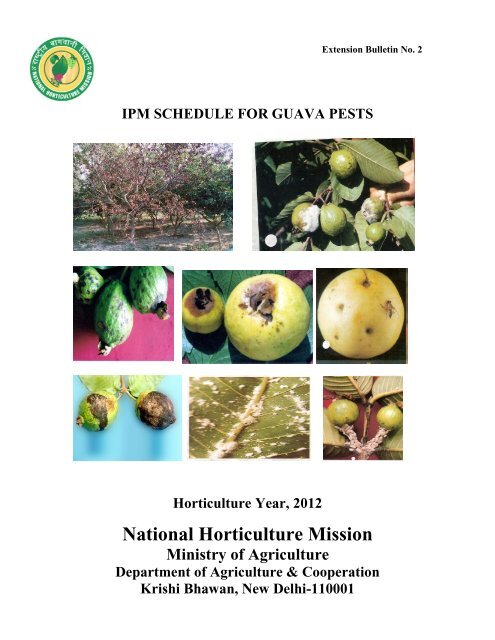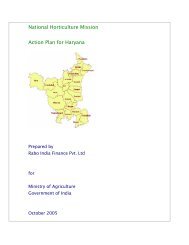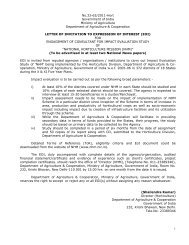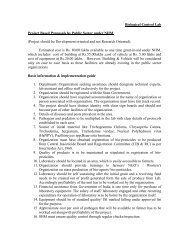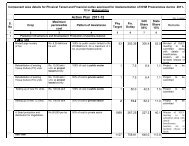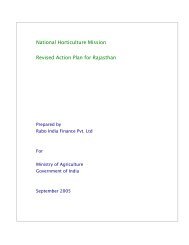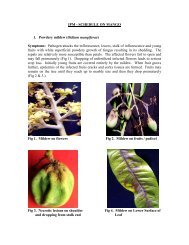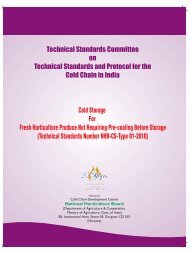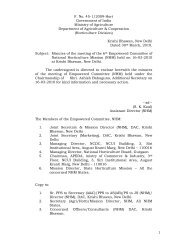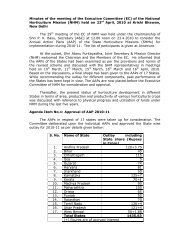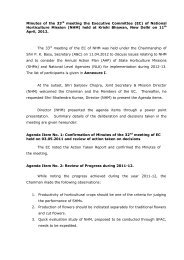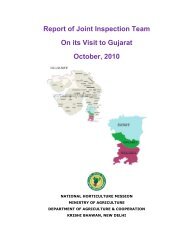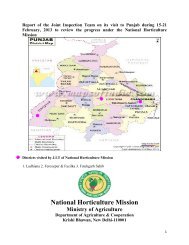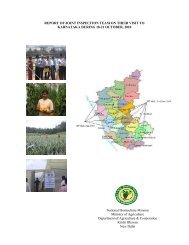Guava - National Horticulture Mission
Guava - National Horticulture Mission
Guava - National Horticulture Mission
Create successful ePaper yourself
Turn your PDF publications into a flip-book with our unique Google optimized e-Paper software.
4. Lack of timely application of suitable control measures.Management: Following practices are required for the management of the disease:Disease can be kept under check by proper sanitation in the orchard. Wilted treesshould be uprooted, burnt and trench should be dug around the tree trunk.While transplanting, roots of plants should not be damaged severely.Maintenance of proper tree vigour by timely and adequatelyManuring, intercutlure and irrigation enable them to withstand infection.The pits may be treated with formalin and kept covered for about 3 days andtransplanting should be done after two weeks.Organic manures, oil cakes and lime also check the disease.Use of rootstocks resistant to wilt could be an alternative effective method for thecontrol of disease. Cross of Psidium malle x P. guajava has been found free fromwilt and this material can be used as resistant root stock.Eco-friendly approach of guava wilt control is suggested where biological control,soil amendment and intercropping are effective.Biological control by Aspergillus niger strain AN-17 is found effective.Aspergillus niger multiplied in FYM @ 5 kg/pit, applied in the pits while plantingnew plants. In older plants Aspergillus niger enriched FYM can be applied @ 10kg plant 1.Partially wilted plants recovered fully after rejuvenation / heavy pruning of thetree.2. Anthracnose: [Gloeosporium psidii (Delacroix Sacc. = Glomerella psidii (Del.)Sheld./ Colletotrichum psidii Curzi.]Symptoms: Die back phase: The plant begins to die backwards form the top of a branch.Young shoots, leaves and fruits are readily attached, while they are still tender. Thegreenish colour of the growing tip is changed to dark brown and later to black necroticareas extending backwards causing the die back. The fungus develops from the infectedtwigs and then petiole and young leaves. These may droop down or fall leaving the driedtwigs without leaves. The disease appears in epidemic form, during August toSeptember.Fruit and leaf infection phase: Fruit and leaf infection is generally seen in rainyseason crop. Pin-head spots are first seen on unripe fruits, which gradually enlarge.Spots are dark brown in colour, sunken, circular and have minute black stromata in thecenter of the lesion, which produce creamy spore masses in moist weather. Several spotscoalesce to form bigger lesions (Fig 2 &3). The infected area on unripe fruits becomecorky and hardy, and often develops cracks in case of severe infection. Unopened budsand flowers are also affected by disease which caused their shedding. On leaves, thefungus causes necrotic lesions at the tip or on the margin. These lesions are usually ashygrey and bear fruiting bodies.
Fig. 2 Disease on young fruitsFig. 3. Disease on mature fruitMode of spread:1. By wind borne spores available on dead leaves, twigs and mumified fruits in theorchard.2. Dense canopy is congenial for germinating of spores due to suitable moistureregime.3. Movement of planting material through infected foliage4. Transportation of fruits from high disease pressure area without any treatment.Reasons for severity:1. Closer planting without canopy management2. Lack of timely harvesting3. Availability of free water in the farm of dew or rains encourages spore productionand its dispersal around canopy.4. Lack of timely application of control measures.Management: Spray of Bordeaux mixture (3:3:50) or Copper oxychloride (0.3 %) just afterinitiation of disease. For post harvest treatment, 20 min. dip in 500 ppm tetracycline is effective. Application of bio agent viz Streptosporangium pseudovulgare on fruitsbefore emergence of symptom (Fig.4)
3. Canker [ Pestalotia psidii Pat.]Fig. 4. Bio controlSymptoms: The disease generally occurs on green fruits and rarely on leaves. The firstevidence of infection on fruit is the appearance of minute, brown or rust coloured,unbroken, circular, necrotic areas, which in advanced stage of infection; tears open theepidermis in a circinate manner. The margin of lesion is elevated and a depressed area isnoticeable inside. The crater like appearance is more noticeable on fruits than on leaves(Fig. 5). The canker is confined to a very shallow depth and does not penetrate deep inthe flesh of the fruit. In older cankers, white myceliums consisting of numerous sporesare noticeable. In severe cases, raised, cankerous spots develop in great numbers and thefruits break open to expose seeds. The infected fruits remain underdeveloped, becomehard, malformed and mummified and drop. Sometimes, small rusty brown angular spotsappear on the leaves. In winter, the cankerous spots are common but in rainy seasonminute red specks are formed. In cv. Sardar (Lucknow-49), development of cankerpustule is large, more elevated and numerous.Fig. 5. Canker on fruitMode of Spread: The pathogen is primily a wound parasite and avoid injury to fruits.Reason for Severity: Germination of spores is maximum at 30 0 C and do notgerminate below 15 0 C or above 40 0 C with 98% RH.
Management: The spread of disease (in early stage of infection) is controlled by 3 to 4sprays of 1 per cent Bordeaux mixture or lime sulphur at 15 days interval.4. Algal leaf and Fruit Spot [Cephaleuros virescens Kuntze (= C mycoidae Karst.), C.parasiticus]Symptoms: Alga infects immature guava leaves during early spring flush. Minute,shallow brown velvety lesions appear on leaves and as the disease progresses, the lesionsenlarge to 2-3 mm in diameter. On leaves the spots may vary form specks to big patches.They may be crowded or scattered. Leaf tips, margins or areas near the mid vein aremost often infected (Fig. 6). On immature fruits the lesions are nearly black. As fruitsenlarge, lesions get sunken. Cracks frequently develop on older blemishes as a result ofenlargement of fruits, lesions are usually smaller than leaf spots. They are darkish greento brown or black to colour. Disease begins to appear from April and is more seriousduring May to August. The pathogen sporulates readily during the period of high rainfall(July-September) and the disease incidence is greatest during September. In winter,symptoms are not available.Fig. 6 Algal spots on leavesManagement: The control of alga can be achieved by sprays of Copper oxychloride(0.3%) 3-4 times at an interval of 15 days when initial symptoms noticed.5. Cercospora Leaf Spot ( Cercospora sawadae Yamamoto)Symptoms: The disease appears as water soaked, brown irregular patches on the lowersurface and yellowish colour on the upper surface of the leaf. Older leaves are mostlyaffected and the severely affected leaves curl and subsequently drop off (Fig. 7).
Fig. 7 Cercospora Leaf spotManagementSpray mancozeb or Dithane-M-45 (0.2%) at monthly interval.6. Sooty mould [Phragmocapnias betle, Scorias philippensis, Tichomeriumgrandisporum, Limacinula musicola, Aithaloderma clavatisporum, Tripospermum sp.,Polychaeton sp., Leptoxyphium sp. and Conidiocarpus sp.]Symptoms: Sooty mould proliferates in abundance on the foliage of guava, subsisting onthe honeydew secreted by scale insects, aphids, white flies and mealy bugs. Symptomsconsist of blackish brown velvety thin membranous covering on the leaves. In severecases, the foliage appears black due to heavy infection. The affected leaves curl andshrivel under dry conditions (Fig 8)Fig. 8 Sooty MouldManagement:1. The control of disease consists in removing the cause by destroying the insects.The mould will die out for want of suitable growth medium if honeydew-secretinginsects are killed by suitable insecticides.2. Foliar spraying of wettasul + chloropyriphos+Gum Accecia (0.2+ 0.1 +0.3%) at15 days interval has been found very effective.7. Damping off of Seedlings (Rhizoctonia solani Kuhn).
ManagementBoth pre emergence and post emergence phases of the disease are observed. Inpre emergence phase the infected seeds and seedlings show water soaked discoloration,the seed becomes soft and ultimately rots. The affected young seedlings are killed beforethey reach the soil surface. In post emergence phase, hypocotyle at ground level or upperleaves are discolored into yellowish to brown colour, which spreads downwards and laterturn soft and finally rot and constrict. The affected seedlings ultimately topple down anddie. Strands of mycelium may appear on the surface of the plants under humid conditions.The pathogen is also responsible for causing fruit rot, if they are kept on soil after harvestor touching the ground. The disease occurs in warm wet growing area during rainyseason. Initially, lesions appear firm, brownish and water soaked enlarging intoirregular-shaped sunken cankers (Fig 9). Rotting is rapid and infected fruit becomecovered with dense grayish brown mould. Sclerotial bodies are seen in due course of timeon fruits.Fig. 9. Damping off guava seedlingsManagement:1. Diseased seedlings and weeds should be removed and burnt.2. Excessive use of water and close planting should be avoided as the organism ismoisture loving. Seedbeds should be prepared with proper drainagearrangement.3. As the fungus survives on several hosts, planting of susceptible hosts should beavoided.4. Two minute dipping of guava seeds in captan / thiram (0.2%) is advocatedbefore seed sowing.5. Drenching of soil with Copper oxychloride (0.3%) helps in reducing thediseases intensity in nursery.8. Phytophthora fruit rot [Phytophthora parasitica Dastur/ P. nicotianae var.parasitica, P. citricola]Symptoms:The symptom starts at calyx disc of the fruit during rainy season. Affected area iscovered with whitish cotton like growth which develops very fast as the fruit matures andpathogen is able to cover almost the entire surface within a period of 3-4 days duringhumid weather. Under high relative humidity, the fruits near the soil level covered withdense foliage are most severely affected. The fallen fruits are badly affected. The skin ofthe fruit below the whitish cottony growth becomes a little soft, turns light brown to dark
own and emits a characteristics unpleasant smell ultimately such fruits either remainintact or drop off from the tree (Fig 10 & 11).Mode of spread:1. Rain and the wind are important for spread.2. The pathogen produces a great number of sporangia (Spores) on the surface ofdiseased tissues principally when the temperature is near 25 0 C and this is animportant source of inoculums in the development of epidemics.3. Drops of rain are necessary for the liberation of sponrangia from the infectedplant material or soil.4. Infection ceases when temperature is less than 15 0 C or more than 35 0 CReason for Severity:1. Cool, wet environmental conditions with high soil moisture favour diseaedevelopment.2. High humidity, temperature from 28-32 0 C, poorly drained soils and injuries areimportant for initiation of disease.3. Lack of timely fungicidal sprays.4. Close plantation.Fig. 10 Phytophthora on foliage
Fig. 11 Phytophthora fruit rot on green fruitsWhen the disease appears on young and half grown fruits, they shrink, turn dirtybrown to dark brown, hard in texture either remain intact as mummified fruit or drop off.The disease incidence varies from 8-30%, depending upon the weather and foliageconditions.Management: Dithane Z-78 (0.2%) or Ridomil or Aliette (0.2%) or Copper oxychloride(0.3%) are found effective to control foliar infection. Soil drenching with Copper oxychloride (0.3%) or Ridomil or Aliette (0.2%) Plant spacing and fertilizer régimes should be managed to avoid unnecessarilydense plant canopy.9. Stylar end rot [Phomopsis psidii De camara and P. destructim]Symptoms:The visible disease symptom is the discoloration in the region lying just belowand adjoining the persistent calyx. Such area gradually increases in size and turn darkbrown. Later the affected area becomes soft. Along with the discoloration of epicarp, themesocarp tissue also shows discoloration and the diseased area is marked by being pulpyand light brown in colour in contrast to the bright white colour of the healthy area of themesocarp (Fig. 12)
Fig.12. Stylar end rotAt an advanced stage due to disorganization of the inner affected tissues, size ofthe fruit shrinks and concentric wrinkles develop on the skin. Finally the affected fruit iscovered with dark colour pycnidia. Serious losses up to 10% occur in the orchard ifdisease is not properly controlled.Management: Spray Copper oxychloride (0.3%) or carbendazim or Thiophonate methyl (0.1%)before onset of winter fruiting. However, care should be taken that no spraying is done 15 days prior toharvesting. Avoid fruit injury.10. Soft watery rot (Botryodiplodia theobromae Pat)SymptomsThe infection starts as a brownish discoloration mostly at the stem end and itgradually proceeds downwards in an irregular wavy manner. Finally the whole fruit mayget involved. The decay takes the form of a soft, watery break down, resulting frominfection via wound or through the stem end. In advanced cases, numerous smallpycnidia are produced over the entire surface of the fruit (Fig 13.)
Fig. 13Soft watery rotManagement(i) Ensure careful handling in order to reduce the incidence of wounding(ii) Captan and homeopathic drug arsenic oxide are found effective against thefungus(iii) Applications of Bacillus subtilis and Streptosporangium pseudovulgare onguava fruits have been found effective.11. Botryosphaeria rot (Botryosphaeria ribis Gross. & Duggar)SymptomsThe disease has been identified as Botryosphaeria ribis which cause seriouslosses during December. The infection usually occurs at or near the distal end in theregion of persistent calyx. The rot begins with a translucent zone around the distal endthat becomes brown in colour. With the evolution of the disease, the lesion becomes darkblack and wrinkled with dry skin, while maintaining translucent margins (Fig. 14)Fig. 14. Botryosphaeria rotSpots on the skin of the fruit often slightly sunken that tends to increase in sizewith the formation of Pycnidia embedded in the disease tissues as lesions age containingcharacteristics spores. The fungus produces asexual stage is responsible for infection inthe orchards.
Management: Orchard sprays with Copper oxychloride (0.3%)/ dithane M 45 (0.2%) at15 days interval.12. Hyaloderma leaf spot (Hyaloderma sp.)Symptoms:The fungus preferentially infects mature leaves during wet weather. In the moreadvanced stage, when the conditions are highly favourable, the disease can cause a severespot on the leaves around middle lamina. Under humid conditions, it is common to seethe brick red colour spots (Fig. 15& 16).Fig. 15. Hyaloderma leaf spot (lower surface)Fig. 16 Hyaloderma leaf spot (upper surface)On the lower surface of the leaves, in the areas corresponding to the spot, thegrowth of the fungus can be observed. Abundant spotting causes defoliation of leaf. Thelesions spread easily to healthy leaves, and can coalesce forming a large irregular to semicircular lesions area on the surface of the leaf, upto 4-5 mm in diameter, sharply defined,and occasionally depressed. Initial infections on the underside of the leaf may causechlorotic patches or spots to occur on the upper side of leaf. Since, it is a new disease,more research is warranted, to know its epidemiology, biology and control etc.Management: The diseases could be managed with Copper oxychloride (0.3%) spray duringrainy season.13. Parasites (Loranthus sp.)Symptoms:The guava tree is the prey of many parasites and the most interesting of these areso called phanerogamic parasites and epiphysis. <strong>Guava</strong> trees are commonly affected with
these parasites particularly in the neglected orchards. They are commonly present ontrunk or branches of the tree, thus making the tree weak. The foliage infected host plant issparse, reduced in size and its bearing capacity and quality of fruit is considerablylowered. Since the appearance of parasitic plants is quite distinct from the guava host,they can be easily distinguished in infected trees. The point at which the guava host ispenetrated is usually characterized by swollen growths called “burrs”. The burrs help inthe identification of sites at which the parasite has entered the host, an important featurewhile controlling these plants (Fig. 17).Fig. 17. Parasite(Loranthus sp.)Management1. The affected branches should be cut sufficiently to eradicate the haustoria. In earlystages, it can be removed easily. If small bit of haustorium is left in the host, itre-grows with renewed vigour and soon starts damaging the host as before.2. Cuttings out affected portion of tree for enough below burrs to remove haustoria andcut surface is treated with wound dresser viz. Copper oxychloride (0.39%)paste/spray to prevent the secondary pathogens infecting through wounds.3. Spraying of emulsion of diesel (30-40%) in soap water is recommended as it wasfound affective.B. INSECTSAbout 80 species of insects have been recorded on guava trees, affecting yield andquality of fruits. Of these, less than 20 species occupy the status of major potential andminor pests. Rests of them are casual feeders. Fruit flies, bark-eating caterpillars, fruitborer and coccids (scale insects and mealy bugs) are considered as major pest of guava,while aphids, white flies, thrips, cockchafers, stem borers and fruit borers, etc., are theminor pests.14. Fruit FlyThe fruit fly is the most destructive insect in the production of guava, particularlyduring rainy season. <strong>Guava</strong> fruits are attacked by a number of fruit flies includingBactrocera cucurbitae, B. correcta, B. diversus, B. dorsalis, and B. zonata. These pestsare widely distributed throughout the country and are polyphagous pests, breeding on anumber of fruits and vegetables and as such are of great economic importance. The
main species, infesting guava in North India, have been identified as B. correctus and B.Zonatus. Eggs are laid on ripening fruits (Fig18.) and the maggots feed on pulp of fruits.Pupation takes place in the soil. In North India, after the harvesting of mango, the pestshifts over to guava with the peak population in July-August, thereafter, populationdeclines and larvae hibernate in winter.Symptoms: Ovipositional damage in the form of minute depressions may be seen fromoutside (Fig. 18). Fruit soften at the site of infestation. The affected fruits rot and dropdown prematurely. Ovipositional apertures lead to secondary infection by severalpathogens.Fig. 18. Fruit fly with ovipositional damagepheromoneFig 19. Fruit flies attracted to drop ofManagement To check the carryover of the pest, collect and destroy fallen and infested fruitsalong with fruit fly maggots. Tillage of tree basin also helps in checking the pest population as the pupae andhibernating larvae are destroyed by natural enemies. Hanging of methyl eugenol bottle traps (containing 100 ml solution of 0.1%methyl eugenol & 0.1% malathion) is highly effective in controlling the pests.It is also helpful in early detection of this pests and monitoring of its population.Ten such traps may be hanged in a hectare at a height of 5-6 ft, well before theripening of fruits. If mango orchard is in the vicinity, traps should be hangedform the second week of April. The solution may be changed at weekly intervals.15. Bark- Eating Caterpillar [ Indarbela tetraonis Moore and I. quadrinotata(Walker)]Symptoms: The infestation of this pest may be identified by the presence of irregulartunnels and patches covered with silken web consisting of excreta and chewed upwood particles on the shoots, branches, stem and main trunk (Fig.20 ). Shelter holesmay also be seen particularly at the joints of shoots and branches. The young shootsdry and die away giving sickly look to the plant (Fig.21).
Fig. 20 Damage of bark eating caterpillaron trunkFig. 21. Infestation of bark eatingcaterpillar on twigs.Management: Keep the orchard clean and healthy to prevent the infestation of this pest. Detect early infestation by periodically looking out for drying young shoots. Kill the caterpillars mechanically by inserting the iron spike in shelter holesmade by these borers at early stages of infestation. In case of severe infestation, remove the webs and insert the swab of cottonwool soaked in 0.05 per cent dichlorovos or inject water emulsion of 0.05 percent monocrotophos or 0.05 per cent chlorpyriphos and plug the holes withmud.16. Fruit borers(i)Pomegranate butterfly: [Deudorix (Virachola) isocrates (Fab)]The pomegranate butterfly, D. isocrates is a main pest of pomegranate, butrecently infestation of this pest has been reported increasing in guava growing regions ofUttar Pradesh and other places in North India. The attack of this pest occurs in fruitingseason both in rainy and winter season crops. The violet brown female butterfly laysshiny, white eggs singly on calyx of flowers and fruits. The larva bores the fruit (Fig.22)and feed on the flesh and seeds, making the fruit hollow from inside (Fig 23). The larvais flattened, stout built, covered with short hair and about 2 cm long mature larvae maycome out and pupate near the exit hole or many remain inside. Infestation of this pestresults in fruit loss. The entry and exit holes of the larvae also pave way for secondaryinfection by different pathogens.(ii)Castor capsule borer: [D punctiferalis (Guenee)]This borer is another polyphagous insect, larvae of which damage fruits of guava.It is a primarily a pest of castor but also attacks guava, and other fruits and forest treesand occasionally cause serious damage. Larvae of this moth mainly bore fruits but theymay also bore buds and tender shoots. The mature larva is pinkish in colour, speckled
with minute black spots, measuring about 1.5 cm in length. The larvae feed on pulp andseeds of developing fruits resulting in premature dropping of fruits. The pupa is formedin pupal chamber made inside at the basal end of the fruit. The infestation of this insecttakes place in rainy season guava.Fig.22 Fruits damaged by D. isocratesFig 23. Larvea (D. isocrates) inside thedamaged fruitsFig. 24. Fruits damaged by D. punctiferalisSymptoms: The affected fruits are generally deformed at the point of entry of larvae.Larvae faeces may be seen exuding out of the borer hole (Fig. 24). Such fruits weaken,rot and drop down.Management: Cultivation of pomegranate should be discouraged close to guava as this is themost preferred host of this pest. Regular collection of infested fruits and their destruction to check the furtherspread and carryover the population. To prevent the infestation of pest, spray carbaryl (0.2%) or ethophenprox (0.05%)at the beginning of fruiting season and before ripening of fruits. At least 15 dayswaiting period should be observed before beginning of harvest. The spray may berepeated at fortnightly intervals depending on severity of attack.
17. CoccidsA large number of coccids have been reported infesting leaves, shoots and fruitsof guava. Only few of them are of regular occurrence. The common species areChloropulvinaria psidii, Drosicha mangiferae, Ferisia virgata, Hemiaspidioproctuscinerus and Nipaecoccus viridis, Planococcus citrii, Saisetia oleae, S. coffeae, etc. C.psidii is the main scale insect causing serious damage to guava crop in Central and SouthIndia.Sporadic incidences of N. viridis on fruits and F. virgata on leaves and shootshave been recorded in North India. F. virgata occasionally appears in large numbersparticularly on young plants. The adults are conspicuous, secreting white, glossy threadsof wax encircling the body. Body is covered with waxy powder. Eggs are laid in groupsin ovisacks. Nymph after hatching feed on leaves and shoots (Fig. 25 ). The attacks ofthese insects are more common in summer.Fig. 25. Infestation of mealy bug D. mangiferae on leafIncidence of mango mealy bug, Drosicha magiferae has been noticed in winterseason corp. The nymphs suck sap form leaves, shoots and fruits. Development ofsooty mould takes place on the honeydew excreted by these insects on the affected parts(Fig. 26) The infested fruits drop prematurely and mature fruits loose their market value.
Fig. 26. Infestation of mango mealy bug on fruitsSymptoms:Excessive de-sapping results in yellowing, withering, drying and shedding ofleaves, drying of young shoots and dropping of affected fruits. Secondary infection ofsooty mould takes place on honeydew, excreted by these insects, hindering thephotosynthetic activity of the plant.Management: The affected leaves and young shoots may be pruned and destroyed along withthe pest in early fruiting of non-fruiting season. It helps in brining down theinitial pest population and prevents further spread. Overlapping and overcrowding branches may also be pruned to check spread ofthese pests in the orchards. In case of heavy infestation of F. virgata, spray of 0.1 per cent buprofezin or0.045 per cent dimethoate in early fruiting season or non-fruiting season issuggested. Spray may be repeated at fortnightly intervals depending on theseverity of attack. For prevention and control of mango mealy bug, (D. magiferae) alkathenebanding (400 gauge 25 cm wide) may be tied with the help of thread on treetrunk. In case of heavy infestation, 1.5 per cent chlorpyriphos dust @ 250 gm/tree may be applied by raking the soil round the tree trunk. This may be doneparticularly when guava orchards are located in the vicinity of mango orchards. Releasing of Cryptolaemus montrouzieri @ 3000 /ha before fruiting season.


